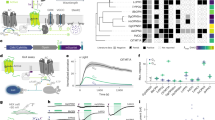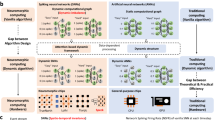Abstract
IT has been suggested that after repetitive activation motor nerve endings become hyperpolarized and that consequently the spike potential in the endings is larger in amplitude and more effective in transmission1. An alternative suggestion is that activation causes a mobilization of transmitter in the terminals so that more is available for release2. If the spike potential could be recorded in the terminals, it would give information about the relative importance of these two hypotheses. Hitherto this has been impossible in a mammalian preparation because there was no reliable method of locating the microscopically small endings. This difficulty can, however, be overcome by using as a criterion the ability to record extracellular miniature end-plate potentials, for it is generally accepted that this is only possible within a few micra of junctional regions3.
This is a preview of subscription content, access via your institution
Access options
Subscribe to this journal
Receive 51 print issues and online access
$199.00 per year
only $3.90 per issue
Buy this article
- Purchase on Springer Link
- Instant access to full article PDF
Prices may be subject to local taxes which are calculated during checkout
Similar content being viewed by others
References
Lloyd, D. P. C., J. Gen. Physiol., 33, 147 (1949).
Eccles, J. C., The Physiology of Nerve Cells (Oxford Univ. Press, 1957).
del Castillo, J., and Katz, B., J. Physiol., 132, 630 (1956). Dudel, J., and Kuffler, S. W., J. Physiol., 155, 514 (1961).
Hubbard, J. I., J. Physiol., 159, 507 (1961).
Hubbard, J. I., Nature, 184, 1945 (1959).
Hubbard, J. I., and Schmidt, R. F., Nature, 191, 1103 (1961).
Hubbard, J. I., and Willis, W. D., J. Physiol., 163, 115 (1962).
Author information
Authors and Affiliations
Rights and permissions
About this article
Cite this article
HUBBARD, J., SCHMIDT, R. Repetitive Activation of Motor Nerve Endings. Nature 196, 378–379 (1962). https://doi.org/10.1038/196378a0
Issue Date:
DOI: https://doi.org/10.1038/196378a0
This article is cited by
-
Changes in frequency of motor end-plate miniature potentials after transient tetanic stimulation of the motor nerve
Bulletin of Experimental Biology and Medicine (1968)
Comments
By submitting a comment you agree to abide by our Terms and Community Guidelines. If you find something abusive or that does not comply with our terms or guidelines please flag it as inappropriate.



